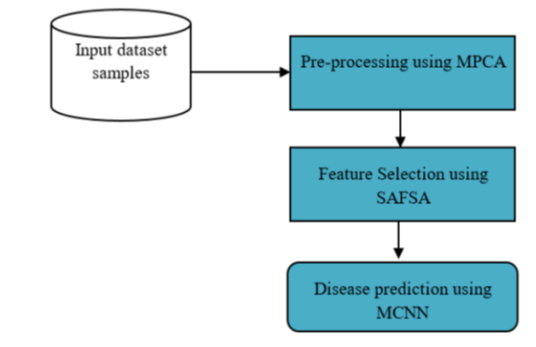


Indian Journal of Science and Technology
Year: 2021, Volume: 14, Issue: 17, Pages: 1406-1421
Original Article
K Jeyalakshmi1*, R Rangaraj2
1Associate Professor, Department of Computer Science, Hindusthan College of Arts and Science, Coimbatore, Tamil Nadu, India
2Professor and Head, Department of Computer Science, Hindusthan College of Arts and Science, Coimbatore, Tamil Nadu, India
*Corresponding Author
Email: [email protected]
Received Date:15 March 2021, Accepted Date:28 April 2021, Published Date:17 May 2021
Objectives: To introduce the technique which can ensure the accurate and reliable prediction of liver disease by adapting the deep learning technique. Methods: In this work Modified Convolutional Neural Network based Liver Disease Prediction System (MCNN-LDPS) is introduced for the accurate liver disease prediction outcome. In the proposed research work, Dimensionality reduction is carried out using Modified Principal Component Analysis. Optimal feature selection is carried out using Score based Artificial Fish Swarm Algorithm (SAFSA). In SAFSA algorithm, information gain and entropy values are taken as input values which proved accurate outcome. This research method has been analysed over Indian Liver patient dataset. Findings: The analysis of the research work proves that the proposed method MCNN-LDPS obtains better outcome in terms of increased accuracy, precision. Here comparison analysis proved that MCNN-LDPS obtains 4.05% increased accuracy, 21.23% F-measure, 4.22% precision and 34.26% recall. This research method has been compared with the existing Multi layer Perceptron Neural Network (MLPNN) for the performance analysis. Novelty: The major limitation of CNN is its inability to encode Orientational and relative spatial relationships, view angle. CNN do not encode the position and orientation of data. Lack of ability to be spatially invariant to the input data sample. This is resolved in this research work by combining the genetic algorithm with the CNN method.
Keywords: Liver Disease Prediction; Feature Selection; Information Gain; Entropy; Convolutional neural network; Dimensionality Reduction
© 2021 Jeyalakshmi & Rangaraj.This is an open-access article distributed under the terms of the Creative Commons Attribution License, which permits unrestricted use, distribution, and reproduction in any medium, provided the original author and source are credited. Published By Indian Society for Education and Environment (iSee)
Subscribe now for latest articles and news.